Results day for Level 3 qualifications including A-Levels and T-Levels is just a week away. As always, we’ll be posting analysis of the main trends on the day.
This year, for the first time, we’ll also be hosting a results day webinar where we’ll bring you all our analysis live. It’s on 15 August – the day after results come out – and is completely free. Sign up now to book your place.
And, in the meantime, this post rounds up everything that we’ll be looking out for on the day.
1. We expect A-Level entry numbers to fall
We were rather surprised to see that the provisional entries data shows that the number of A-Level entries is down this year. That’s despite the fact that, according to the best estimates available from the ONS, the population of 18 year olds in England has increased by nearly 11,000 since last year.
But a closer look at the figures does offer some explanation. First, it’s worth pointing out that the ONS has not directly published estimates of the 18 year old population for this year or for last year. The figures that we’re using come from data published in 2023; we’re assuming that the population of 18 year olds in 2024 was the same as the population of 17 year olds in 2023, and similarly with 16 year olds for 2025.
These population estimates will therefore not be entirely accurate. But even if we assume that they are, a fall in A-Level entries is not that surprising. Let’s look at how entry numbers and the estimated population of 18 year olds has changed over the last five years.
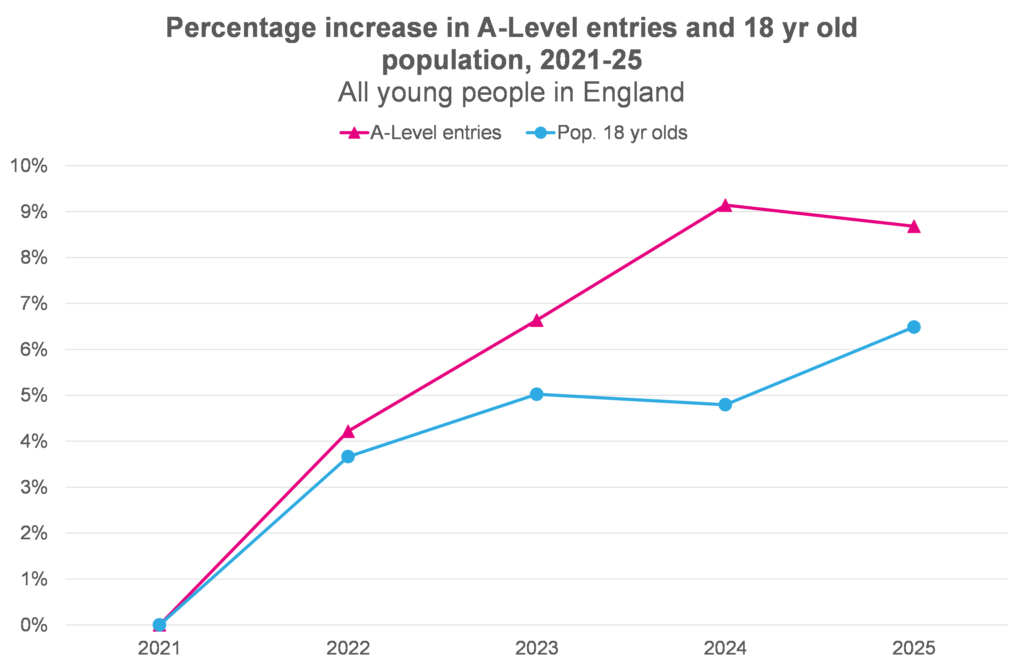
Sign up to our newsletter
If you enjoy our content, why not sign up now to get notified when we publish a new post, or to receive our half termly newsletter?
Between 2021 and 2022, A-Level entry numbers increased at a similar rate to the population of 18 year olds. In 2023 and 2024, however, entry numbers increased more sharply than the estimated population of 18 year olds, which actually fell in 2024.
So it looks as though the decrease in entry numbers this year may just be a case of entries falling back to the norm after unusually high numbers in 2023 and 2024. The high entries in the last two years will have (largely) come from students who took GCSEs in 2021 and 2022. GCSEs taken in those years were more likely to receive top grades than GCSEs taken in 2023. So it follows that this year’s cohort were less likely to have the grades required to go on to enter A-Levels.
While those who took GCSEs in 2020 were also more likely to receive higher grades, it may be that the belated changes to the grading system made that year came too late in the day to affect most decisions on KS5 options.
2. Entries to T-Levels will increase as more pathways are offered
The first T-Levels were introduced just five years ago, with the first cohort completing their qualifications in 2022. With more pathways being introduced each year, entry numbers have been rising sharply.

Unfortunately, unlike A-Levels, provisional data on entry numbers is not published for T-Levels, so we don’t yet know how much of an increase to expect.
It’ll be interesting to see how T-Level students are spread around the country as numbers increase. Last year, they were more likely than A-Level students to be at schools and colleges in the North or South West, and less likely to be in London or the East of England.

We’ll also be keeping an eye out for figures on retention rates. One in three T-Level students from the first cohort dropped out without completing the qualification. Last year, this was down to 29%: an increase, but one that certainly leaves room for improvement. In comparison, according to DfE figures, drop-out rates for those who took three A-Levels last year were just 10%.
3. The future of other Level 3 qualifications remains uncertain
Much of the analysis that comes out on results days focuses on A-Levels and T-Levels, partly because very little data on other qualifications is actually published on the day. But they are far from the only routes open to students.
According to DfE figures, only two thirds of the Key Stage 4 cohort go on to complete a Level 3 qualification (equivalent to 2 A-Levels) by age 19. Of those that do, nearly a third take a qualification other than A-Levels or T-Levels.
The table below shows the number of students achieving Level 3 by age 19 last year, broken down by route. Note that the majority of students included here would have completed their qualification(s) aged 18 in 2022/23.

Other routes through Level 3 are varied, but some of the most popular qualifications include BTECs, VRQs and Cambridge Technicals.
We’ll be looking at the figures on entries and grading for these qualifications when they come out, but we’ll also be asking what’s in store for them in the future.
We asked the same question last year, and we’re not really any closer to knowing the answer. With the continuing roll-out of T-Levels and the defunding of some BTECs, we might expect entry numbers to vocational and technical qualifications (VTQs) other than T-Levels to fall this year. On the other hand, with entries to A-Levels falling this year, we could see an increase in numbers taking alternative qualifications.
The situation for VTQs is complicated. Many qualifications remain funded for now, although the uncertainty surrounding this may have put centres off offering the qualifications. But resistance to plans to replace BTECs with T-Levels continues, and we even may see it prevail, leading to defunding plans being pushed back further or even abandoned.
We don’t have provisional figures for entries to BTECs and other VTQs, and we expect limited data to be published on results day. But we’ll be keeping a close eye on what we do get, and on the situation over the next few months and years.
4. Some A-Level subjects will see rises (and falls) in entries that buck the overall trend
Returning to A-Levels for a moment, provision data shows that despite the overall fall in entry numbers, we’re set to see an increase in entries to several STEM subjects – maths, chemistry, physics and further maths. All of these subjects also saw an increase in entries last year.
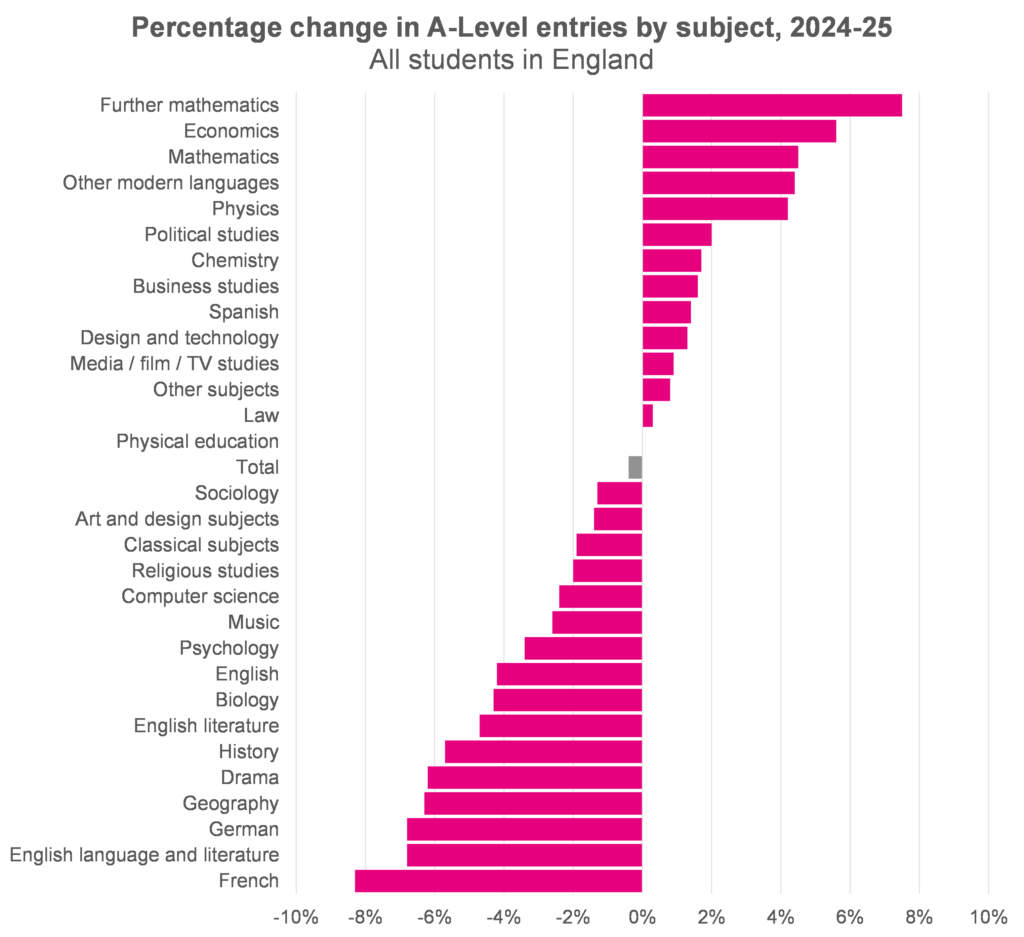
Biology and computer science, on the other hand have both seen a slight dip in entries this year. But, for both of these subjects, this follows several years of increases, and entries for both subjects this year remain well above entries in 2021.
Other A-Level subjects with big increases since last year include economics and other modern foreign languages. At the other end of the scale, French, combined English literature and language, and German all saw a drop in entries.
Let’s take a look the rankings for the most popular A-Level subjects. This year the top four most are the same as last year: maths, psychology, biology and chemistry.
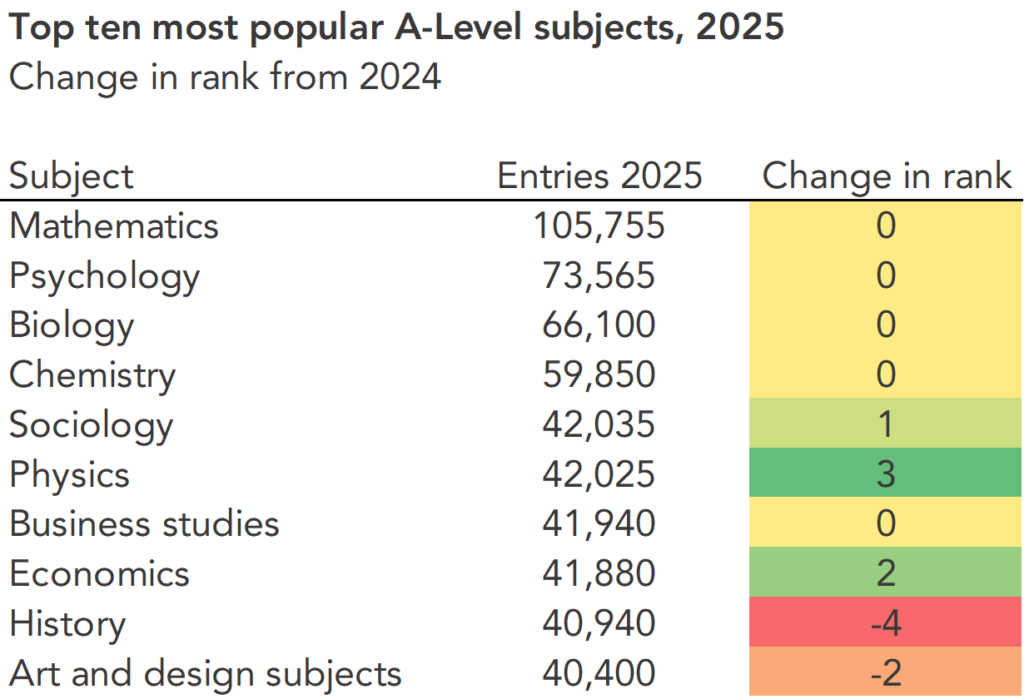
Sociology, physics and economics have all moved up in the rankings compared to last year, while history and art and design subjects have moved down.
5. Will we see changes in gender balance?
We’ll be interested to see how entry numbers break down between male and female students. Last year, there were some huge differences for T-Level students.
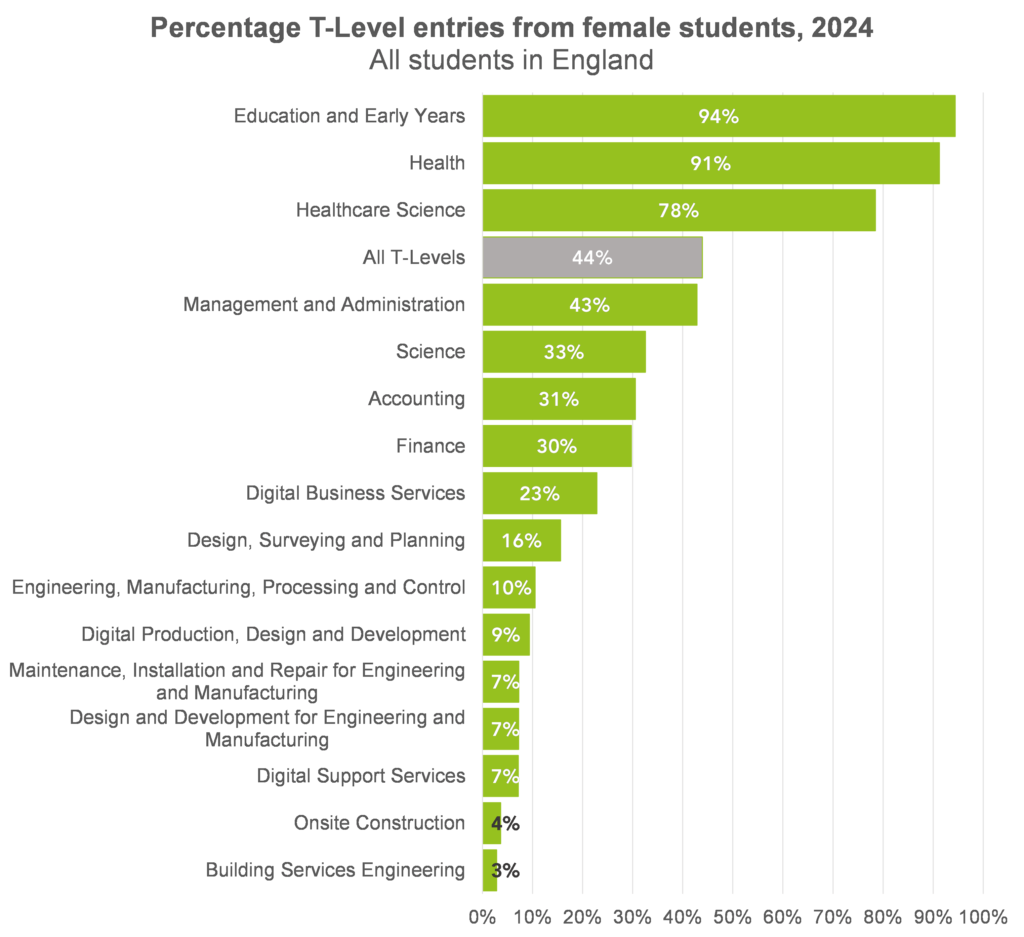
Education and early years, and health both included more than 90% female students. And seven of the sixteen pathways included at least 90% male students.
For A-Level students, there were also some big differences, although for most subjects not so extreme as at T-Level.
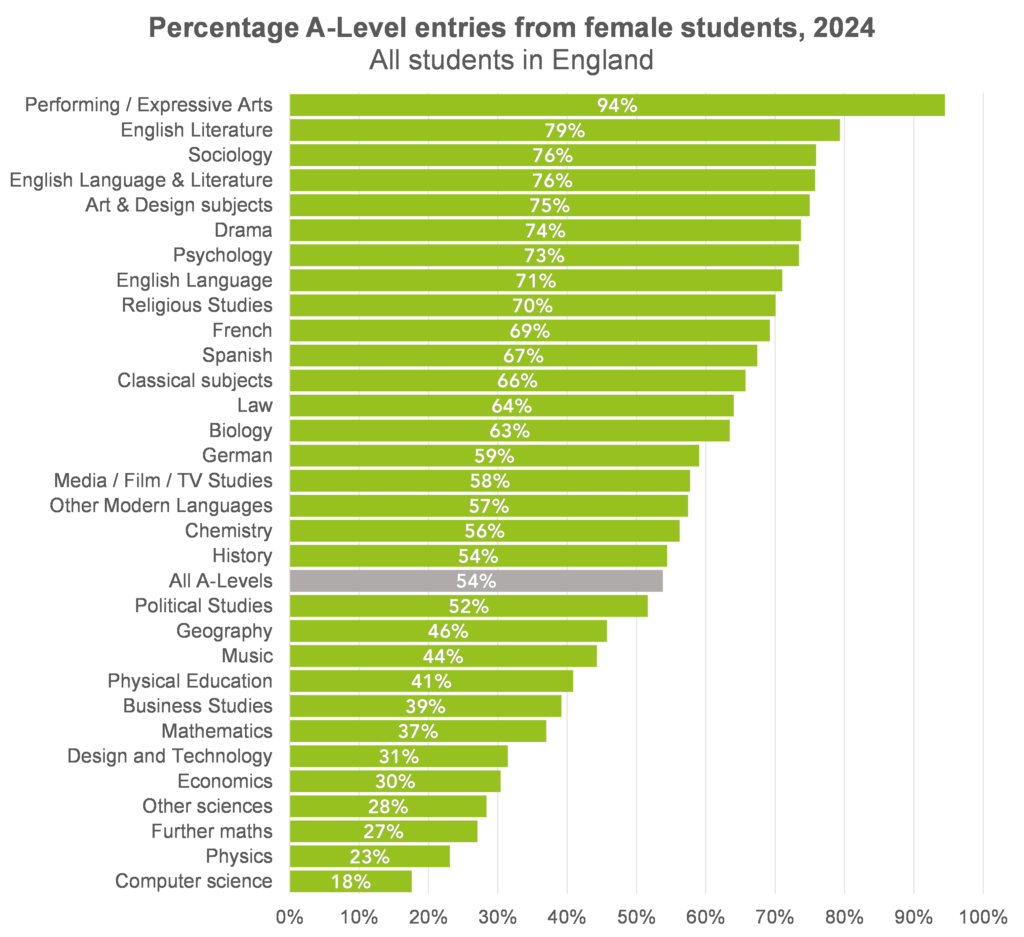
While computer science had the lowest percentage of female students last year at just 18%, that was actually an improvement: the figure had stood at 15% since 2020. This year, with the fall in entries to computer science, it’ll be interesting to see if that change is reversed.
Don’t miss our results day webinar at 10am on 15 August. Sign up now for your free place.
Want to stay up-to-date with the latest research from FFT Education Datalab? Sign up to Datalab’s mailing list to get notifications about new blogposts, or to receive the team’s half-termly newsletter.



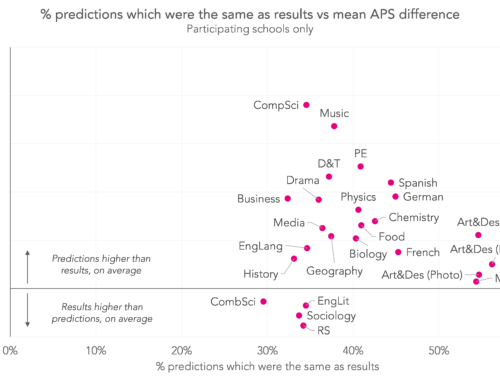

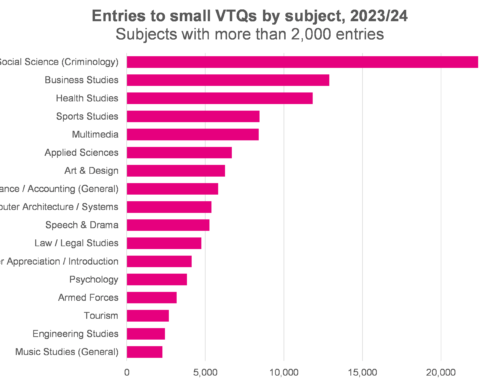

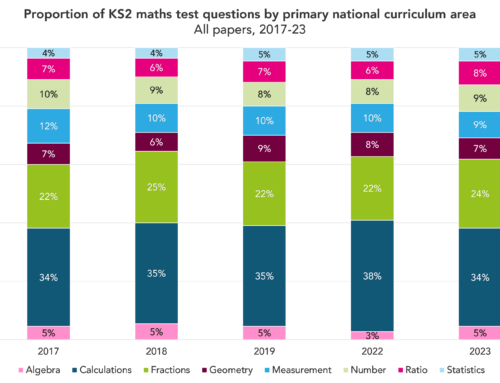
You note the growth in ‘other modern languages ‘. But my suspicion is that almost all of this is due to candidates who have this as a second (possibly primary) language at home. Fifty percent of my students are in this situation (one out of two in total! ).
Which also identifies a second issue, which is that the numbers taking other modern languages is quite small. The percentage measure hides this.
Best wishes
David Chamberlain
Hi David, thanks for commenting. I think you’re probably right about other MFL entries from students who speak that language at home. Also worth noting that there’s been a steady increase over the last few years after a massive fall in entries in 2019-20.
Fair point on the number of entries. The increase for other MFL was just 275 students, compared to 1,310 for further maths, 2,200 for economics and 4,525 for maths. I did um and ah over whether to show a chart of entry numbers or percentage changes. Both can be misleading in their own way, I think. The answer should perhaps have been belt and braces – include both!
No mention of Criminology which I believe there has been a large number of students taking.
Hi Judy, thanks for raising this. Criminology A-Level entries are not reported separately in DfE’s provisional entry figures, which we used as the source data for much of this post. They roll subjects with a relatively low number of entries (less than 2,000) together into ‘other subjects’. Obviously without the figures we can’t comment on entry numbers, but if the numbers for criminology are close to that threshold (and getting higher) they may be reported separately in future. Figures on entries to other qualifications haven’t been published yet either, so we can’t comment on any of them at a subject level at the moment.
Rest assured that we will comment away if and when we do get our hands on some data!
Criminology isn’t reported in the Ofqual stats as it isn’t an A Level – it’s a Level 3 Applied Certificate/Diploma.
Criminology’s numbers would rival most A Levels, though. By 2024, it was up to 21,000 for the Certificate and 25,000 for the Diploma (across the UK, not just England).
The numbers are pretty easy to find as only WJEC offers the qualification, so they are on its website: https://www.wjec.co.uk/home/administration/results-grade-boundaries-and-prs/results-statistics-archive/
Thanks Philip, those numbers are very comparable with lots of A-Levels. It’s a shame we don’t get provisional figures for qualifications other than A-Levels. Or more easily accessible figures on and after results day, for that matter.